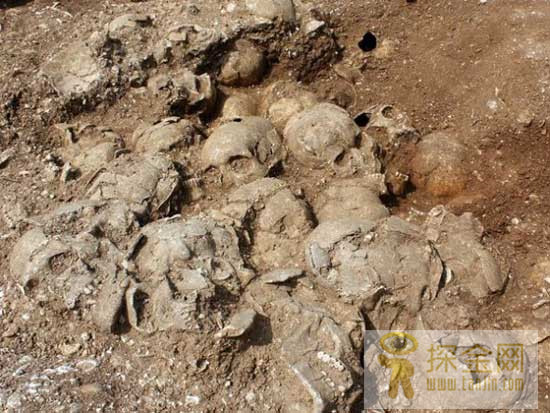
According to media reports on November 13, according to media reports, the identity of 51 young men with bare headless bones discovered by archaeologists in Britain has been confirmed. They are pirates decapitated. The beheading of the bones — skulls piled aside — was discovered in June 2009 in a pit of 1,000 years of execution. The death pit is located near the seaside in the town of Weymouth.
The results of radiocarbon dating show that these young men lived between 910 and 1030 AD when the United Kingdom was fighting pirates and often defeated. But until recently, the identity of these bones has still not been confirmed. Of the 10 skulls, the owner was about 20 years old. Analysis of his teeth showed that the pirates came from different parts of Scandinavia and one person might come from the northern part of the Arctic Circle.
This study on the identity of the headless remains was led by Jane Evans, the National Isotope Earth Science Laboratory at the National Environment Research Council. They studied the isotopes that could leak leaked chemical markers. Isotopes can reveal where a person comes from. For example, oxygen isotopes in drinking water stay in the teeth as they age.
Based on the phenomenon of isotope ratios as a function of climate change, Evans confirmed that these young men come from regions with a colder climate than Britain. He said: "Isotope ratios indicate that these people are not British, and are more likely to come from Norway and Sweden." Nitrogen isotope analysis results show that these people like to eat meat high-protein foods, similar to those living in Sweden during the same period.
Evans said: "It is curious that piracy is notorious for viciousness, looting and rape, but the evidence we have found also paints a different group of pirates. The Anglo-Saxons rounded up at the time. Pirates killed them."
A reproducible study led by David Skoal of Oxford Archeology found the piracy pit. He said that many of the bones had deep cuts on the head, ankles, and neck, indicating that these pirates were prisoners of war and had been beheaded. "A lot of people seem to have been tortured many times." Other scars indicate that some pirates tried to rebel against the executioners. One of them's fingers was cut off as proof.
Skulls are piled on the side of the death pit, which may be to show victory. Surprisingly, archaeologists did not find any clothing debris in the death pit, indicating that the pirates were buried naked. Skelly said: "Even if weapons and valuables are taken away, we should find bone buttons or something like that, but so far we haven't got anything. These headless pirates are a group of physically strong young people. They are First-rate fighters."
Skolai said that the bones were buried on the top of a hill, and the main road leading to Weymouth was next to the top of the hill. This also shows that the identity of these headless corpses is pirates. He said: "In late Saxon and in the Middle Ages, British soldiers were usually executed in places like this. If you are a pirate, you are more likely to start a slaughter in town or on the beach."
The founder of the historical reproduction society Regia Anglorum stated that although the piracy was cruel, there was not much difference between the pirates and the early British fighters on the battlefield. "When the two sides battle, if they stand in front of you, it is difficult to tell which pirates are and which are Saxons." Their main weapons are spears, and spare weapons are swords and axes.
(Wechat accepts daily probe industry select content)

Ammonium dihydrogen phosphate (NH4H2PO4) is a white crystalline solid that is soluble in water. It is commonly used as a fertilizer, flame retardant, and food additive. It is also used in the production of ceramics, pharmaceuticals, and detergents. Ammonium dihydrogen phosphate is a source of both nitrogen and phosphorus, two essential nutrients for plant growth. It is often used in combination with other fertilizers to provide a balanced nutrient supply to crops. Ammonium dihydrogen phosphate is also used as a flame retardant in plastics and textiles, as it releases ammonia when heated, which dilutes the combustible gases and inhibits combustion. In the food industry, it is used as a leavening agent in baking powders and as a pH regulator in soft drinks.
Ammonium dihydrogen phosphate (ADP) is a colorless, crystalline compound with the chemical formula NH4H2PO4. It is commonly used as a fertilizer and as a food additive. ADP is also used in the manufacturing of ceramics, electronics, and other products.
ADP is soluble in water and has a slightly acidic pH. It is a highly reactive compound and can react with strong bases to form ammonium phosphate. ADP is also a source of phosphorus and nitrogen, which are essential nutrients for plant growth.
In addition to its use as a fertilizer, ADP is used in the production of ammonium polyphosphate, which is used as a flame retardant and in the manufacturing of plastics. ADP is also used in the production of specialty glasses and in the preparation of buffer solutions for laboratory use.
ADP has been classified as a hazardous substance by the United States Environmental Protection Agency due to its potential to cause harm to human health and the environment. It can cause skin and eye irritation, and inhalation of the dust can cause respiratory problems. ADP can also contribute to eutrophication, which is the excessive growth of algae in water bodies, leading to oxygen depletion and harm to aquatic life.
Fertilizer Diammonium Phosphate DAP, Diammonium Phosphate DAP Fertilizer,Diammonium Hydrogen Phosphate Fertilizer
Sichuan Jinhe Qihang Co,. Ltd. , https://www.jqfoodadditives.com